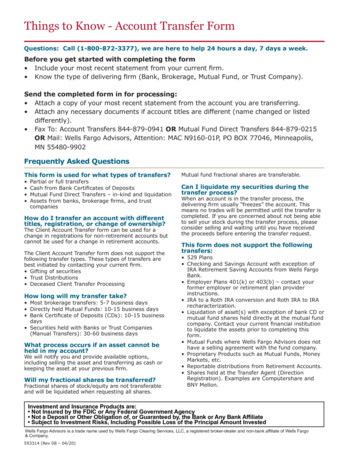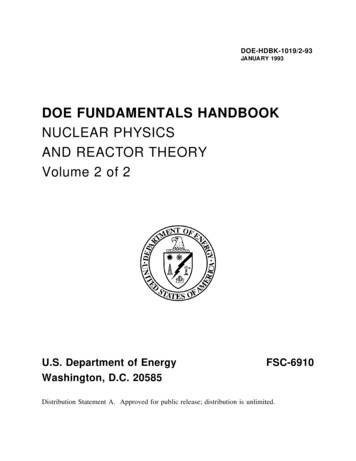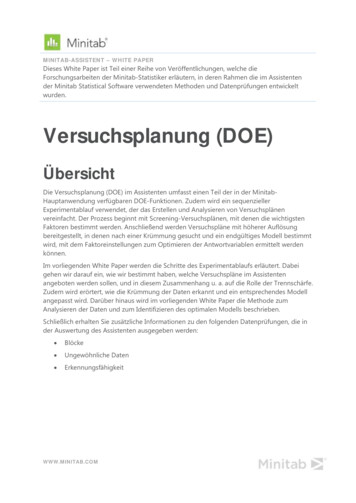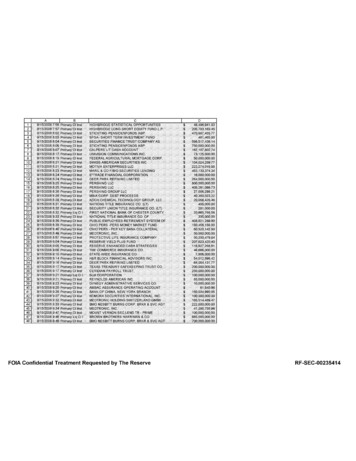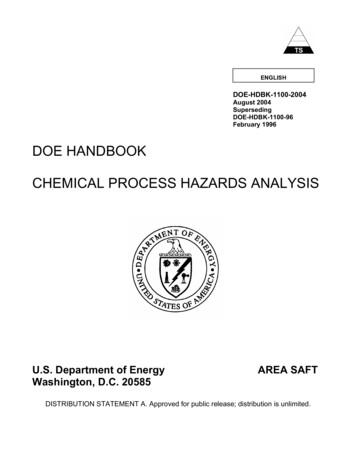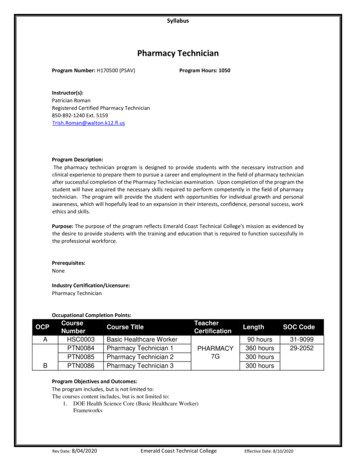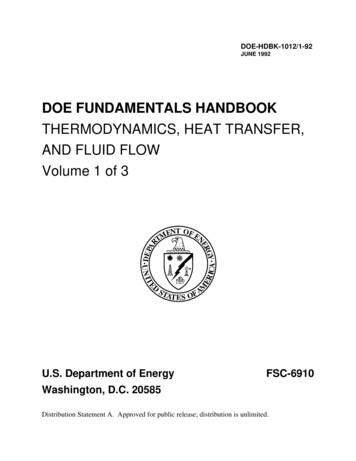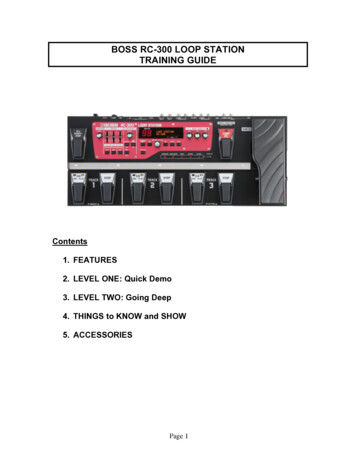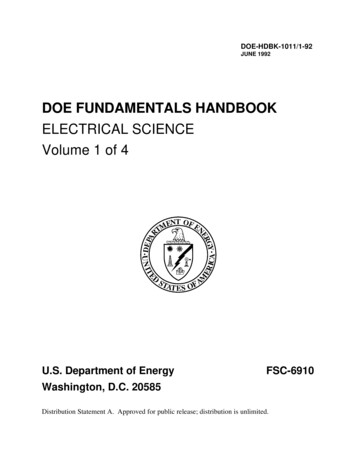
Transcription
DOE-HDBK-1011/1-92JUNE 1992DOE FUNDAMENTALS HANDBOOKELECTRICAL SCIENCEVolume 1 of 4U.S. Department of EnergyFSC-6910Washington, D.C. 20585Distribution Statement A. Approved for public release; distribution is unlimited.
This document has been reproduced directly from the best available copy.Available to DOE and DOE contractors from the Office of Scientific and Technical Information.P. O. Box 62, Oak Ridge, TN 37831; (615) 576-8401.Available to the public from the National Technical Information Service, U.S. Department ofCommerce, 5285 Port Royal Rd., Springfield, VA 22161.Order No. DE92019785
ELECTRICAL SCIENCEABSTRACTThe Electrical Science Fundamentals Handbook was developed to assist nuclear facilityoperating contractors provide operators, maintenance personnel, and the technical staff withthe necessary fundamentals training to ensure a basic understanding of electrical theory,terminology, and application. The handbook includes information on alternating current (AC)and direct current (DC) theory, circuits, motors, and generators; AC power and reactivecomponents; batteries; AC and DC voltage regulators; transformers; and electrical testinstruments and measuring devices. This information will provide personnel with a foundationfor understanding the basic operation of various types of DOE nuclear facility electricalequipment.Key Words: Training Material, Magnetism, DC Theory, DC Circuits, Batteries, DCGenerators, DC Motors, AC Theory, AC Power, AC Generators, Voltage Regulators, ACMotors, Transformers, Test Instruments, Electrical DistributionRev. 0ES
ELECTRICAL SCIENCEFOREWORDThe Department of Energy (DOE) Fundamentals Handbooks consist of ten academicsubjects, which include Mathematics; Classical Physics; Thermodynamics, Heat Transfer, andFluid Flow; Instrumentation and Control; Electrical Science; Material Science; MechanicalScience; Chemistry; Engineering Symbology, Prints, and Drawings; and Nuclear Physics andReactor Theory. The handbooks are provided as an aid to DOE nuclear facility contractors.These handbooks were first published as Reactor Operator Fundamentals Manuals in1985 for use by DOE category A reactors. The subject areas, subject matter content, and levelof detail of the Reactor Operator Fundamentals Manuals were determined from several sources.DOE Category A reactor training managers determined which materials should be included, andserved as a primary reference in the initial development phase. Training guidelines from thecommercial nuclear power industry, results of job and task analyses, and independent input fromcontractors and operations-oriented personnel were all considered and included to some degreein developing the text material and learning objectives.The DOE Fundamentals Handbooks represent the needs of various DOE nuclearfacilities' fundamental training requirements. To increase their applicability to nonreactor nuclearfacilities, the Reactor Operator Fundamentals Manual learning objectives were distributed to theNuclear Facility Training Coordination Program Steering Committee for review and comment.To update their reactor-specific content, DOE Category A reactor training managers alsoreviewed and commented on the content. On the basis of feedback from these sources,information that applied to two or more DOE nuclear facilities was considered generic and wasincluded. The final draft of each of the handbooks was then reviewed by these two groups. Thisapproach has resulted in revised modular handbooks that contain sufficient detail such that eachfacility may adjust the content to fit their specific needs.Each handbook contains an abstract, a foreword, an overview, learning objectives, andtext material, and is divided into modules so that content and order may be modified byindividual DOE contractors to suit their specific training needs. Each subject area is supportedby a separate examination bank with an answer key.The DOE Fundamentals Handbooks have been prepared for the Assistant Secretary forNuclear Energy, Office of Nuclear Safety Policy and Standards, by the DOE TrainingCoordination Program. This program is managed by EG&G Idaho, Inc.Rev. 0ES
ELECTRICAL SCIENCEOVERVIEWThe Department of Energy Fundamentals Handbook entitled Electrical Science wasprepared as an information resource for personnel who are responsible for the operation of theDepartment's nuclear facilities. A basic understanding of electricity and electrical systems isnecessary for DOE nuclear facility operators, maintenance personnel, and the technical staff tosafely operate and maintain the facility and facility support systems. The information in thehandbook is presented to provide a foundation for applying engineering concepts to the job.This knowledge will help personnel more fully understand the impact that their actions may haveon the safe and reliable operation of facility components and systems.The Electrical Science handbook consists of fifteen modules that are contained in fourvolumes. The following is a brief description of the information presented in each module of thehandbook.Volume 1 of 4Module 1 - Basic Electrical TheoryThis module describes basic electrical concepts and introduces electricalterminology.Module 2 - Basic DC TheoryThis module describes the basic concepts of direct current (DC) electrical circuitsand discusses the associated terminology.Volume 2 of 4Module 3 - DC CircuitsThis module introduces the rules associated with the reactive components ofinductance and capacitance and how they affect DC circuits.Module 4 - BatteriesThis module introduces batteries and describes the types of cells used, circuitarrangements, and associated hazards.Rev. 0ES
ELECTRICAL SCIENCEModule 5 - DC GeneratorsThis module describes the types of DC generators and their application in termsof voltage production and load characteristics.Module 6 - DC MotorsThis module describes the types of DC motors and includes discussions of speedcontrol, applications, and load characteristics.Volume 3 of 4Module 7 - Basic AC TheoryThis module describes the basic concepts of alternating current (AC) electricalcircuits and discusses the associated terminology.Module 8 - AC Reactive ComponentsThis module describes inductance and capacitance and their effects on ACcircuits.Module 9 - AC PowerThis module presents power calculations for single-phase and three-phase ACcircuits and includes the power triangle concept.Module 10 - AC GeneratorsThis module describes the operating characteristics of AC generators andincludes terminology, methods of voltage production, and methods of parallelingAC generation sources.Module 11 - Voltage RegulatorsThis module describes the basic operation and application of voltage regulators.Volume 4 of 4Module 12 - AC MotorsThis module explains the theory of operation of AC motors and discusses thevarious types of AC motors and their application.Rev. 0ES
ELECTRICAL SCIENCEModule 13 - TransformersThis module introduces transformer theory and includes the types oftransformers, voltage/current relationships, and application.Module 14 - Test Instruments and Measuring DevicesThis module describes electrical measuring and test equipment and includes theparameters measured and the principles of operation of common instruments.Module 15 - Electrical Distribution SystemsThis module describes basic electrical distribution systems and includescharacteristics of system design to ensure personnel and equipment safety.The information contained in this handbook is by no means all encompassing. An attemptto present the entire subject of electrical science would be impractical. However, the ElectricalScience handbook does present enough information to provide the reader with a fundamentalknowledge level sufficient to understand the advanced theoretical concepts presented in othersubject areas, and to better understand basic system and equipment operations.Rev. 0ES
Department of EnergyFundamentals HandbookELECTRICAL SCIENCEModule 1Basic Electrical Theory
Basic Electrical TheoryTABLE OF CONTENTSTABLE OF CONTENTSLIST OF FIGURES . . . . . . . . . . . . . . . . . . . . . . . . . . . . . . . . . . . . . . . . . . . . . . . . . . ivLIST OF TABLES . . . . . . . . . . . . . . . . . . . . . . . . . . . . . . . . . . . . . . . . . . . . . . . . . . . viREFERENCES . . . . . . . . . . . . . . . . . . . . . . . . . . . . . . . . . . . . . . . . . . . . . . . . . . . . viiOBJECTIVES . . . . . . . . . . . . . . . . . . . . . . . . . . . . . . . . . . . . . . . . . . . . . . . . . . . . . viiiATOM AND ITS FORCES . . . . . . . . . . . . . . . . . . . . . . . . . . . . . . . . . . . . . . . . . . . . 1The Atom . . . . . . . . . . . . . . .Electrostatic Force . . . . . . . . .The First Law of ElectrostaticsElectrostatic Field . . . . . . . . .Potential Difference . . . . . . . .Free Electrons . . . . . . . . . . . .Summary . . . . . . . . . . . . . . .1233568ELECTRICAL TERMINOLOGY . . . . . . . . . . . . . . . . . . . . . . . . . . . . . . . . . . . . . . . . 9Conductors . . . . . . . .Insulators . . . . . . . . .Resistors . . . . . . . . . .Voltage . . . . . . . . . .Current . . . . . . . . . . .Real and Ideal SourcesSummary . . . . . . . . . 9. 9. 910101212UNITS OF ELECTRICAL MEASUREMENT . . . . . . . . . . . . . . . . . . . . . . . . . . . . . . . 13System Internationale (SI)Voltage . . . . . . . . . . . .Current . . . . . . . . . . . . .Resistance . . . . . . . . . .Ohm’s Law . . . . . . . . . .Conductance . . . . . . . . .Power . . . . . . . . . . . . .Rev. 0Metric System.Page i.13131414141616ES-01
TABLE OF CONTENTSBasic Electrical TheoryTABLE OF CONTENTS (Cont.)Inductance . . . . . . . . . . . . . . . . . . . . . . . . . . . . . . . . . . . . . . . . . . . . . . . . . . 17Capacitance . . . . . . . . . . . . . . . . . . . . . . . . . . . . . . . . . . . . . . . . . . . . . . . . . 17Summary . . . . . . . . . . . . . . . . . . . . . . . . . . . . . . . . . . . . . . . . . . . . . . . . . . . 18METHODS OF PRODUCING VOLTAGE (ELECTRICITY) . . . . . . . . . . . . . . . . . . . . 19Electrochemistry . . .Static Electricity . . .Magnetic Induction .Piezoelectric Effect .Thermoelectricity . . .Photoelectric Effect .Thermionic EmissionSummary . . . . . . . .1920212122232426MAGNETISM . . . . . . . . . . . . . . . . . . . . . . . . . . . . . . . . . . . . . . . . . . . . . . . . . . . . . 27Magnetism . . . . . . . . . . . . . . . . . . .Magnetic Flux . . . . . . . . . . . . . . . . .Magnetic Flux Density . . . . . . . . . . .Magnetic Materials . . . . . . . . . . . . .Electromagnetism . . . . . . . . . . . . . .Polarity of a Single Conductor . . . . .Magnetic Field and Polarity of a CoilMagnetomotive Force . . . . . . . . . . . .Field Intensity . . . . . . . . . . . . . . . . .Reluctance . . . . . . . . . . . . . . . . . . .Summary . . . . . . . . . . . . . . . . . . . .2729293031313233343536MAGNETIC CIRCUITS . . . . . . . . . . . . . . . . . . . . . . . . . . . . . . . . . . . . . . . . . . . . . . 37Magnetic Circuits . . . . . . . . . . . .BH Magnetization Curve . . . . . . .Hysteresis . . . . . . . . . . . . . . . . . .Magnetic Induction . . . . . . . . . . .Faraday’s Law of Induced VoltageLenz’s Law . . . . . . . . . . . . . . . . .Summary . . . . . . . . . . . . . . . . . .ES-01.Page ii.37394041424344Rev. 0
Basic Electrical TheoryTABLE OF CONTENTSTABLE OF CONTENTS (Cont.)ELECTRICAL SYMBOLS . . . . . . . . . . . . . . . . . . . . . . . . . . . . . . . . . . . . . . . . . . . . 45Symbols . . . . . . . . . . . . . . . . . . . . . . . . . . . . . . . . . . . . . . . . . . . . . . . . . . . . 45Summary . . . . . . . . . . . . . . . . . . . . . . . . . . . . . . . . . . . . . . . . . . . . . . . . . . . 47APPENDIX A Metric System and Powers of Ten . . . . . . . . . . . . . . . . . . . . . . . . . . . A-1Rev. 0Page iiiES-01
LIST OF FIGURESBasic Electrical TheoryLIST OF FIGURESFigure 1The Atom . . . . . . . . . . . . . . . . . . . . . . . . . . . . . . . . . . . . . . . . . . . . . . . 1Figure 2The Carbon Atom . . . . . . . . . . . . . . . . . . . . . . . . . . . . . . . . . . . . . . . . . 2Figure 3Electrostatic Force . . . . . . . . . . . . . . . . . . . . . . . . . . . . . . . . . . . . . . . . . 2Figure 4Electrostatic Field . . . . . . . . . . . . . . . . . . . . . . . . . . . . . . . . . . . . . . . . . 3Figure 5Electrostatic Field Between Two Charges of Opposite Polarity . . . . . . . . . . 4Figure 6Electrostatic Field Between Two Charges of Like Polarity . . . . . . . . . . . . . 4Figure 7Potential Difference Between Two Charged Objects . . . . . . . . . . . . . . . . . 5Figure 8Energy Shells and Electron Quota . . . . . . . . . . . . . . . . . . . . . . . . . . . . . . 6Figure 9Electron Flow Through a Copper Wire with a Potential Difference . . . . . . 11Figure 10Potential Difference Across a Conductor Causes a Current to Flow . . . . . . 11Figure 11Voltaic Chemical Cell . . . . . . . . . . . . . . . . . . . . . . . . . . . . . . . . . . . . . 20Figure 12Static Electricity . . . . . . . . . . . . . . . . . . . . . . . . . . . . . . . . . . . . . . . . . 20Figure 13Generator - Electromagnetic Induction . . . . . . . . . . . . . . . . . . . . . . . . . . 21Figure 14Pressure Applied to Certain Crystals Produce an Electric Charge . . . . . . . 22Figure 15Heat Energy Causes Copper to Give up Electrons to Zinc . . . . . . . . . . . . 23Figure 16Producing Electricity from Light Using a Photovoltaic Cell . . . . . . . . . . . 24Figure 17Vacuum Tube Diode . . . . . . . . . . . . . . . . . . . . . . . . . . . . . . . . . . . . . . 25Figure 18Electron Spinning Around Nucleus Produces Magnetic Field . . . . . . . . . . 27Figure 19Magnetic Domains . . . . . . . . . . . . . . . . . . . . . . . . . . . . . . . . . . . . . . . 28Figure 20The Law of Magnetic Attraction and Repulsion . . . . . . . . . . . . . . . . . . . 28ES-01Page ivRev. 0
Basic Electrical TheoryLIST OF FIGURESLIST OF FIGURES (Cont.)Figure 21The Magnetic Field Produced by Current in a Conductor . . . . . . . . . . . . . 31Figure 22Left-hand Rule for Current Carrying Conductors . . . . . . . . . . . . . . . . . . . 31Figure 23Left-hand Rule for Coils . . . . . . . . . . . . . . . . . . . . . . . . . . . . . . . . . . . 32Figure 24Left-hand Rule to Find North Pole of an Electromagnet . . . . . . . . . . . . . . 33Figure 25Different Physical Forms of Electromagnets . . . . . . . . . . . . . . . . . . . . . . 35Figure 26Magnetic Current with Closed Iron Path . . . . . . . . . . . . . . . . . . . . . . . . 38Figure 27Typical BH Curve for Two Types of Soft Iron . . . . . . . . . . . . . . . . . . . . 39Figure 28Hysteresis Loop for Magnetic Materials . . . . . . . . . . . . . . . . . . . . . . . . . 41Figure 29Induced EMF . . . . . . . . . . . . . . . . . . . . . . . . . . . . . . . . . . . . . . . . . . . 42Figure 30Electrical Symbols . . . . . . . . . . . . . . . . . . . . . . . . . . . . . . . . . . . . . . . . 46Rev. 0Page vES-01
LIST OF TABLESBasic Electrical TheoryLIST OF TABLESTable A-1Base Units of the International Metric System . . . . . . . . . . . . . . . . . . . . A-1Table A-2Supplementary SI Units . . . . . . . . . . . . . . . . . . . . . . . . . . . . . . . . . . . . A-2Table A-3Derived SI Units . . . . . . . . . . . . . . . . . . . . . . . . . . . . . . . . . . . . . . . . . A-3Table A-4Metric Prefixes Used in Electricity . . . . . . . . . . . . . . . . . . . . . . . . . . . . A-4Table A-5Powers of 10 . . . . . . . . . . . . . . . . . . . . . . . . . . . . . . . . . . . . . . . . . . . A-5Table A-6Metric Prefixes Expressed as Powers of 10 . . . . . . . . . . . . . . . . . . . . . . A-8ES-01Page viRev. 0
Basic Electrical TheoryREFERENCESREFERENCESGussow, Milton, Schaum’s Outline Series, Basic Electricity, McGraw-Hill.Academic Program for Nuclear Power Plant Personnel, Volume IV, Columbia, MD:General Physics Corporation, Library of Congress Card #A 326517, 1982.Sienko and Plane, Chemical Principles and Properties, 2nd Edition, McGraw-Hill.Academic Program for Nuclear Power Plant Personnel, Volume II, Columbia, MD:General Physics Corporation, Library of Congress Card #A 326517, 1982.Nasar and Unnewehr, Electromechanics and Electric Machines, John Wiley and Sons.Van Valkenburgh, Nooger, and Neville, Basic Electricity, Vol. 5, Hayden Book Company.Exide Industrial Marketing Division, The Storage Battery, Lead-Acid Type, The ElectricStorage Battery Company.Lister, Eugene C., Electric Circuits and Machines, 5th Edition, McGraw-Hill.Croft, Carr, Watt, and Summers, American Electricians Handbook, 10th Edition, McGrawHill.Mason, C. Russel, The Art and Science of Protective Relaying, John Wiley and Sons.Mileaf, Harry, Electricity One - Seven, Revised 2nd Edition, Hayden Book Company.Buban and Schmitt, Understanding Electricity and Electronics, 3rd Edition, McGraw-Hill.Kidwell, Walter, Electrical Instruments and Measurements, McGraw-Hill.Rev. 0Page viiES-01
OBJECTIVESBasic Electrical TheoryTERMINAL OBJECTIVE1.0Given a simple electrical circuit, APPLY basic electrical theory fundamental principlesto describe circuit operation.ENABLING OBJECTIVES1.1DESCRIBE the following terms:a.Electrostatic forceb.Electrostatic fieldc.Potential differenced.Electromotive force (EMF)e.Ion charge1.2DEFINE the following terms:a.Conductorb.Insulatorc.Resistord.Electron current flowe.Conventional current flowf.Direct current (DC)g.Alternating current (AC)h.Ideal sourcei.Real source1.3DESCRIBE the following electrical parameters, including the unit of measurement andthe relationship to other ancee.Powerf.Inductanceg.Capacitance1.4Given any two of the three component values of Ohm’s Law, DETERMINE theunknown component value.ES-01Page viiiRev. 0
Basic Electrical TheoryOBJECTIVESENABLING OBJECTIVES (Cont.)1.5DESCRIBE how the following methods produce a voltage:a.Electrochemistryb.Static electricityc.Magnetic Inductiond.Piezoelectric effecte.Thermoelectricityf.Photoelectric effectg.Thermionic emission1.6DEFINE the following terms:a.Magnetic fluxb.Magnetic flux densityc.Weberd.Permeabilitye.Magnetomotive force (mmf)f.Ampere turnsg.Field intensityh.Reluctance1.7DESCRIBE the following materials as they relate to permeability, including an exampleand an approximate relative permeability.a.Ferromagnetic materialsb.Paramagnetic materialsc.Diamagnetic materials1.8EXPLAIN the physical qualities of a simple magnetic circuit, including relationships ofqualities and units of measurements.1.9Given the physical qualities of a simple magnetic circuit, CALCULATE the unknownvalues.1.10DESCRIBE the shape and components of a BH magnetization curve.1.11EXPLAIN the cause of hysteresis losses.1.12Given Faraday’s Law of induced voltage:a.DESCRIBE how varying parameters affect induced voltage.b.CALCULATE voltage induced in a conductor moving through a magnetic field.1.13STATE Lenz’s Law of induction.Rev. 0Page ixES-01
OBJECTIVESBasic Electrical TheoryENABLING OBJECTIVES (Cont.)1.14Given a standard electrical symbol, IDENTIFY the component that the symbol represents.The symbols will be for the following rRheostatDiodeGround connectionsVacuum tubem.n.o.p.q.r.s.t.u.v.w.x.y.Page xFuseJunctionAC voltage sourceVoltmeterAmmeterWattmeterRelay operated contactsPotential transformerCurrent transformerWye (Y) connectionDelta ( ) connectionLight bulbBatteryRev. 0
Basic Electrical TheoryATOM AND ITS FORCESATOM AND ITS FORCESWhat is electricity? Electricity is defined as "the flow of electrons through simplematerials and devices" or "that force which moves electrons." Scientists thinkelectricity is produced by very tiny particles called electrons and protons. Theseparticles are too small to be seen, but exist as subatomic particles in the atom.To understand how they exist, you must first understand the structure of the atom.EO 1.1DESCRIBE the following terms:a.Electrostatic forceb.Electrostatic fieldc.Potential differenced.Electromotive force (EMF)e.Ion chargeThe AtomElements are the basic buildingblocks of all matter. The atom isthe smallest particle to which anelement can be reduced while stillkeeping the properties of thatelement. An atom consists of apositively charged nucleussurrounded by negatively chargedelectrons, so that the atom as awhole is electrically neutral. Thenucleus is composed of two kindsof subatomic particles, protons andneutrons, as shown in Figure 1.The proton carries a single unitpositive charge equal in magnitudeto the electron charge.Theneutron is slighty heavier than theFigure 1 The Atomproton and is electrically neutral,as the name implies. These twoparticles exist in various combinations, depending upon the element involved. The electron isthe fundamental negative charge (-) of electricity and revolves around the nucleus, or center, ofthe atom in concentric orbits, or shells.Rev. 0Page 1ES-01
ATOM AND ITS FORCESBasic Electrical TheoryThe proton is the fundamental positivecharge ( ) of electricity and is located inthe nucleus. The number of protons inthe nucleus of any atom specifies theatomic number of that atom or of thatelement. For example, the carbon atomcontains six protons in its nucleus;therefore, the atomic number for carbon issix, as shown in Figure 2.In its natural state, an atom of anyelement contains an equal number ofelectrons and protons.The negativecharge (-) of each electron is equal inmagnitude to the positive charge ( ) ofeach proton; therefore, the two oppositecharges cancel, and the atom is said to beelectrically neutral, or in balance.Electrostatic ForceFigure 2The Carbon AtomOne of the mysteries of the atom is that the electron and the nucleus attract each other. Thisattraction is called electrostatic force, the force that holds the electron in orbit. This force maybe illustrated with lines as shown in Figure 3.Figure 3ES-01Electrostatic ForcePage 2Rev. 0
Basic Electrical TheoryATOM AND ITS FORCESWithout this electrostatic force, the electron, which is traveling at high speed, could not stay inits orbit. Bodies that attract each other in this way are called charged bodies. As mentionedpreviously, the electron has a negative charge, and the nucleus (due to the proton) has a positivecharge.The First Law of ElectrostaticsThe negative charge of the electron is equal, but opposite to, the positive charge of the proton.These charges are referred to as electrostatic charges. In nature, unlike charges (like electronsand protons) attract each other, and like charges repel each other. These facts are known as theFirst Law of Electrostatics and are sometimes referred to as the law of electrical charges. Thislaw should be remembered because it is one of the vital concepts in electricity.Some atoms can lose electrons and others can gain electrons; thus, it is possible to transferelectrons from one object to another. When this occurs, the equal distribution of negative andpositive charges no longer exists. One object will contain an excess of electrons and becomenegatively charged, and the other will become deficient in electrons and become positivelycharged. These objects, which can contain billions of atoms, will then follow the same law ofelectrostatics as the electron and proton example shown above. The electrons that can movearound within an object are said to be free electrons and will be discussed in more detail in alater section. The greater the number of these free electrons an object contains, the greater itsnegative electric charge. Thus, the electric charge can be used as a measure of electrons.Electrostatic FieldA special force is acting betweenthe charged objects discussedabove. Forces of this type are theresult of an electrostatic field thatexists around each charged particleor object. This electrostatic field,and the force it creates, can beillustrated with lines called "linesof force" as shown in Figure 4.Figure 4Rev. 0Page 3Electrostatic FieldES-01
ATOM AND ITS FORCESBasic Electrical TheoryCharged objects repel or attract each other because of the way these fields act together. Thisforce is present with every charged object. When two objects of opposite charge are broughtnear one another, the electrostatic field is concentrated in the area between them, as shown inFigure 5. The direction of the small arrows shows the direction of the force as it would act uponan electron if it were released into the electric field.Figure 5Electrostatic Field Between Two Charges of Opposite PolarityWhen two objects of like charge are brought near one another, the lines of force repel each other,as shown in Figure 6.Figure 6ES-01Electrostatic Field Between Two Charges of Like PolarityPage 4Rev. 0
Basic Electrical TheoryATOM AND ITS FORCESThe strength of the attraction or of the repulsion force depends upon two factors: (1) the amountof charge on each object, and (2) the distance between the objects. The greater the charge onthe objects, the greater the electrostatic field. The greater the distance between the objects, theweaker the electrostatic field between them, and vice versa. This leads us to the law ofelectrostatic attraction, commonly referred to as Coulomb’s Law of electrostatic charges, whichstates that the force of electrostatic attraction, or repulsion, is directly proportional to the productof the two charges and inversely proportional to the square of the distance between them asshown in Equation 1-1.FKq1q2d(1-1)2whereFKq1q2d force of electrostatic attraction or prepulsion (Newtons)constant of proportionality (Coulomb 2/N-m2)charge of first particle (Coulombs)charge of second particle (Coulombs)distance between two particles (Meters)If q1 and q2 are both eitherpositively or negativelycharged, the force is repulsive.If q1 and q2 are oppositepolarity or charge, the force isattractive.Potential DifferencePotential difference is the termused to describe how large theelectrostatic force is betweentwo charged objects. If acharged body is placedbetween two objects with apotential difference, theFigure 7 Potential Difference Between Two Charged Objectscharged body will try to movein one direction, dependingupon the polarity of the object. If an electron is placed between a negatively-charged body anda positively-charged body, the action due to the potential difference is to push the electron towardthe positively-charged object. The electron, being negatively charged, will be repelled from thenegatively-charged object and attracted by the positively-charged object, as shown in Figure 7.Rev. 0Page 5ES-01
ATOM AND ITS FORCESBasic Electrical TheoryDue to the force of its electrostatic field, these electrical charges have the ability to do work bymoving another charged particle by attraction and/or repulsion. This ability to do work is called"potential"; therefore, if one charge is different from another, there is a potential differencebetween them. The sum of the potential differences of all charged particles in the electrostaticfield is referred to as electromotive force (EMF).The basic unit of measure of potential difference is the "volt." The symbol for potentialdifference is "V," indicating the ability to do the work of forcing electrons to move. Becausethe volt unit is used, potential difference is also called "voltage." The unit volt will be coveredin greater detail in the next chapter.Free ElectronsElectrons are in rapid motion around the nucleus. While the electrostatic force is trying to pullthe nucleus and the electron together, the electron is in motion and trying to pull away. Thesetwo effects balance, keeping the electron in orbit. The electrons in an atom exist in differentenergy levels. The energy level of an electron is proportional to its distance from the nucleus.Higher energy level electrons exist in orbits, or shells, that are farther away from the nucleus.These shells nest inside one another and surround the nucleus. The nucleus is the center of allthe shells. The shells are lettered beginning with the shell nearest the nucleus: K, L, M, N, O,P, and Q. Each shell has a maximum number of electrons it can hold. For example, the K shellwill hold
transformers, voltage/current relationships, and application. Module 14 - Test Instruments and Measuring Devices This module describes electrical measuring and test equipment and includes the parameters measured and the principles of operation of common instruments. Mod
